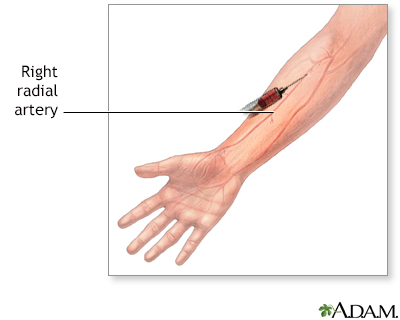Blood gases
Arterial blood gas analysis; ABG; Hypoxia - ABG; Respiratory failure - ABG
Blood gases are a measurement of how much oxygen and carbon dioxide are in your blood. They also determine the acidity (pH) of your blood.
Images

How the Test is Performed
Usually, blood is taken from an artery. In some cases, blood from a vein may be used (venous blood gas).
Most commonly, blood may be collected from one of the following arteries:
- Radial artery in the wrist
- Femoral artery in the groin
- Brachial artery in the arm
Your health care provider may test circulation to the hand before taking a sample of blood from the wrist area.
Your provider inserts a small needle through the skin into the artery. The sample is quickly sent to a lab for analysis.
How to Prepare for the Test
There is no special preparation. If you are on oxygen therapy, the oxygen concentration must remain constant for 20 minutes before the test.
Tell your provider if you are taking any blood-thinning medicines (anticoagulants), including aspirin.
How the Test will Feel
When the needle is inserted to draw blood, some people feel moderate pain. Others feel only a prick or stinging. Afterward, there may be some throbbing or slight bruising. This soon goes away. Pain and discomfort tend to be worse than drawing blood from a vein.
Why the Test is Performed
The test is used to evaluate respiratory diseases and conditions that affect the lungs. It helps determine the effectiveness of oxygen therapy or non-invasive ventilation (BiPAP). The test also provides information about the body's acid/base balance, which can reveal important clues about lung and kidney function and the body's general metabolic state.
Normal Results
Values at sea level:
- Partial pressure of oxygen (PaO2): 75 to 100 millimeters of mercury (mm Hg), or 10.0 to 13.3 kilopascal (kPa)
- Partial pressure of carbon dioxide (PaCO2): 38 to 42 mm Hg (5.1 to 5.6 kPa)
- Arterial blood pH: 7.38 to 7.42
- Oxygen saturation (SaO2): 94% to 100%
- Bicarbonate (HCO3): 22 to 28 millimole per liter (mol/L)
At altitudes of 3,000 feet (900 meters) and higher, the oxygen value is lower.
Normal value ranges may vary slightly among different labs. Some labs include different measurements. Talk to your provider about the meaning of your specific test results.
What Abnormal Results Mean
Abnormal results may be due to lung, kidney, metabolic diseases, or medicines. Head or neck injuries or other injuries that affect breathing can also lead to abnormal results.
Risks
There is little risk when the procedure is done correctly. Veins and arteries vary in size from one person to another and from one side of the body to the other. Taking blood from some people may be more difficult than from others.
Other risks associated with having blood drawn are slight, but may include:
- Fainting or feeling lightheaded
- Multiple punctures to locate blood vessels
- Hematoma (blood buildup under the skin)
- Excessive bleeding
- Infection (a slight risk any time the skin is broken)
Related Information
RespiratoryReferences
Sunwoo BY, Mokhlesi B. Hypercapnia. In: Broaddus VC, Ernst JD, King TE, et al, eds. Murray and Nadel's Textbook of Respiratory Medicine. 7th ed. Philadelphia, PA: Elsevier; 2022:chap 45.
Weinberger SE, Cockrill BA, Mandel J. Evaluation of the patient with pulmonary disease. In: Weinberger SE, Cockrill BA, Mandel J, eds. Principles of Pulmonary Medicine. 7th ed. Philadelphia, PA: Elsevier; 2024:chap 3.
BACK TO TOPReview Date: 8/19/2024
Reviewed By: Allen J. Blaivas, DO, Division of Pulmonary, Critical Care, and Sleep Medicine, VA New Jersey Health Care System, Clinical Assistant Professor, Rutgers New Jersey Medical School, East Orange, NJ. Review provided by VeriMed Healthcare Network. Also reviewed by David C. Dugdale, MD, Medical Director, Brenda Conaway, Editorial Director, and the A.D.A.M. Editorial team.

Health Content Provider
06/01/2025
|
A.D.A.M., Inc. is accredited by URAC, for Health Content Provider (www.urac.org). URAC's accreditation program is an independent audit to verify that A.D.A.M. follows rigorous standards of quality and accountability. A.D.A.M. is among the first to achieve this important distinction for online health information and services. Learn more about A.D.A.M.'s editorial policy, editorial process and privacy policy. A.D.A.M. is also a founding member of Hi-Ethics. This site complied with the HONcode standard for trustworthy health information from 1995 to 2022, after which HON (Health On the Net, a not-for-profit organization that promoted transparent and reliable health information online) was discontinued. |
The information provided herein should not be used during any medical emergency or for the diagnosis or treatment of any medical condition. A licensed medical professional should be consulted for diagnosis and treatment of any and all medical conditions. Links to other sites are provided for information only -- they do not constitute endorsements of those other sites. © 1997- 2025 A.D.A.M., a business unit of Ebix, Inc. Any duplication or distribution of the information contained herein is strictly prohibited.
